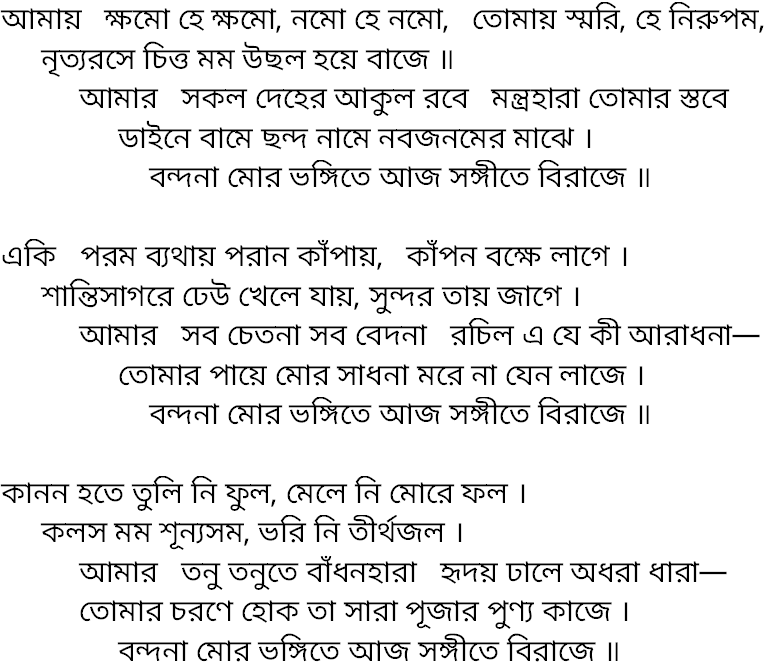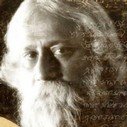Correct Pronunciation of Bengali alphabets: বাংলা বর্ণমালার নির্ভুল উচ্চারণ: Read the article⇗
The next version is coming soon.⇗
Rabindra Sangeet Albums. Sung by the verified singers of this website. 160 talented singers & over 850 songs.
Rabindra Sangeet Collections. Sung by the verified singers of this website. Nearly 500 unique Tagore songs.
Detail information about Rabindra Sangeet. All the lyrics, notations, background history with detail musical compositions, English translation and many more.
Lyric and background history of song amay khamo he khamo
Song of Rabindranath Tagore
This page contains lyric of Tagore song amay khamo he khamo and its transliteration in English with background history. Background of the song includes the place and date of the song written by Rabindranath, name of the newspaper or magazine the song was first published in and the name of the person who had prepared the notation or swaralipi. This page also contains the musical composition of song like parjaay, taal, raag and ango.
The other related elements of this song like translation in English and Hindi, notation in Bengali (swaralipi), staff notation (western) which are available in other pages, please find the related links below. We have also provided the pdf's of lyric, notation and staff notation with midi with downloadable links so that people may find it easier to get the song and notations in printed format.
Musical composition and background history of the song:
Parjaay: Bichitro (1)
Taal: Dadra
Raag: Bhairavi
Written on: 1926 (Boishakh 1333)
Collection: Notir Puja
Swarabitan: 2
Notation by: Roma Majumdar and Dinendranath Tagore / Sahana Debi
Notes: This song was written in summer, 1926.
'Notir Puja' was staged in Shantiniketan for the first time on 25th Boishakh, 1333B (1926), on the sixty-fifth birth anniversary of Rabindranath. Gouri, Daughter of Nandalal Basu had enacted the role of Noti. Her unmatched talent in dance had forced the organizers to decide to stage it in Kolkata. Shantidev Ghosh had written –
… At the end scene of the play the dance performance of Gouri-debi in Manipuri style with the song that was composed in Bhairavi meant for the offering of 'Srimati' had deeply enthralled the entire audience. … Guests from Kolkata had requested Gurudev several times to make a program to stage it at Kolkata. …
It was not customary those days for a middle class lady appear on a public stage. 'Notir Puja' was staged at Jorasanko on the day after Maghotsav 14th Magh 1333B, 25th January, 1927. This incident has been a red letter day for the cultural history of Bengal. Probhatkumar Mukhopadhyay in his biography 'Rabindra-jiboni' has written –
… This incident was especially memorable for the history of dance and culture of Bengal. It was the first time for a dancer from a noble family to appear on a public stage. … Singing in public by dignified ladies had been promoted by the Brahmo-samaj. Dance has been established today as a distinguished form of art in the society by Rabindranath. … In the last twenty-five years [1925-1950] Bengal and India have seen some radical up-gradation of women. The role of Gandhian policies and the Tagorean art, dance in particular, in this up-liftment deserves critical evaluation. …
Amita Sen, in her book 'Shirish Bokul Aamer Mukul', has aptly sketched a scene of the preparation of this dance performance –
… The way to drawing room of Udayan of Uttarayan the right hand staircase from the western verandah leads to an underground room. It would be much cooler in the scorching summer, Rathindranath had presumed. However it lay unused for years until it became associated with the historic dance performance of 'Khamo hey khamo namo hey namo …'. Gouri-di used to visit this room occasionally breaking from the rehearsal and composed the choreography for the song in solitude.
Gurudev explained her the exact expressions to be exhibited for each of the lines, the way Noti would shed off her jewellary one by one. 'You have to convert your dance as your devout offering,' he would say, 'as if you are performing aarti with all your limbs.' Gouri-di, completely engrossed, listened to him quietly. And we saw with utter amazement, the power of prolific inspiration from Gurudev.
Nabakumar Thakur, our dance teacher came up with his Manipuri style and modified moves of Gouri-di accordingly. Patima-bouthan too had helped a lot. The composition was finalized by Gouri-di herself a dance impregnated with bhakti-rasa. The underground room was used for the composition, away from our interference. The rehearsal started in Konark a few days before the stage. One day suddenly Gouri-di presented the dance in front of us which left us mesmerized. … On 25th Boishakh, on the occasion of Gurudev's birthday, Notir Puja was enacted at the Konark building. …
The play was staged for consecutive three days at Jorasanko following Maghotsav. Amita Sen in her book 'Tadeb' has a memoire –
… the play was staged on 14th Magh at Jorasanko. This time only a single male character, Upali, had been included which Rabindranath himself had enacted. … Mr. Santoshkumar Bhanja, would-be husband of Gouri-di and Mr. Nabakrishna Chowdhury, would-be husband of Malati-di had been cordially invited by Gurudev on the occasion.
Santosh-babu and our Naba-da occupied their seat on the front row and Gaganendranath, Samrendranath and Abanindranath sat beside them. One side was graced by the presence of Jagadishchandra Basu and the then Govorner of Bengal on the other. Among the audience present was Ramananda Chattopadhyay, Prashanta Mahalanabish and his wife and several other noble personalities. Abanindranath rushed into the greenroom immediately after the show to congratulate all. Some of the actors received his back-slaps with words of oral encouragement. He was wearing an Arabic long-coat that was a gift from Rabindranath. He took out the coat and wrapped it around Gouri-di saying – 'This is your prize, my dear.' He hugged her as she touched her forehead on his feet. Then he stepped to Nandalal –'Your child has touched the flame, please take care.' …
Report for this drama was published in Anandabazar Patrika twice. On the edition of 29th January, 1927 Notir Puja was praised with a headline 'Rangamanche Rabindranath — Visvabharatir Obhinoy and again on 2nd February, 1927 an essay written by Prafullakumar Sarkar was published.
Lyric in Bengali
All related links of this song
Download or print this lyric
Transliteration in English
Aamai khamo hey khamo, namo hey namo, tomay smori hey nirupamo, Nrityorase chitto mamo uchhal hoye baaje. Aamar sakol deher aakul rabe montrohaara tomar stabe Daaine baame chhando naame nabojanomero maajhe. Bandona mor bhongite aaj songite biraje. Eki paromo byathay paran knaapay, knaapono bokkhe laage. Shaantisaagore dheu khele jaay, sundaro taar jaage. Aamar sab chetona sab bedona rochilo e je ki aaradhona - Tomar paaye mor sadhona mare na jeno laaje. Bandona mor bhongite aaj songite biraje. Kaanon hote tulini phul, mele ni more phal. Kaloso mamo shunyosamo, bhori ni tirthojal. Aamar tonu tonute bnaadhonhaara hridayo dhaale adhara dhara - Tomar charone hok na saara pujaro punyo kaaje. Bandona mor bhongite aaj songite biraje.
More about this song amay khamo he khamo
Get detail information about the song i.e. musical composition, background history, notation, translation and staff notation with downloadable options. Visit the following links.


